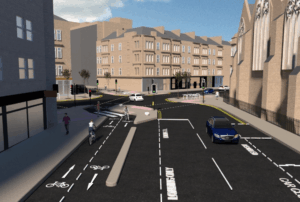Dublin City Council has promised to increase joined-up cycling, walking and wheeling routes from a current total of 10 kilometres to 210 kilometres within nine years.
There will be an additional 90 kilometres of Active Travel infrastructure when the Bus Connects project is complete, according to the new plan.
The Council said the plan should mean 95% of people living in Dublin city will be within 400m of the network which will enable them to get around and across the city.
It promises the infrastructure will be of a high standard with proper segregation from motor traffic.
Dublin City Council Chief Executive Owen Keegan said he is confident it can be delivered.
“The funding is in place, the team is in place and they’re two very important prerequisites to ensure successful delivery,” he said.
However, some active travel projects in the city have proven controversial and difficult to deliver.
The proposed temporary cycle route along Strand Road at Sandymount was abandoned after it was successfully challenged by residents in the High Court.
The Liffey Cycle route along the North Quays has still not been completed because of objections over diversion of motor traffic onto nearby streets.
Lord Mayor of Dublin Caroline Conroy said: “We don’t have time now to think about it, we have to go with it, we have to be fast.
“Our climate is changing faster than we thought and we need to implement any networks that we need to get our people moving quicker, faster in a more environmentally friendly way.”
Widening footpaths and building segregated cycle routes will mean taking road space from motor vehicles and taking away some parking spaces.
Mr Keegan said there will be some people who will lose out.
“Particularly when we’re taking out parking outside shops and businesses. I can’t deny that can have an adverse impact on those businesses,” he said.
“But we’re serving the overall public good by providing a more sustainable transport network. There is a cost to be paid and some businesses, individual homeowners who have on street parking do pay a price but that is outweighed I think by the overall benefit to society as a whole,” he added.
Dublin City’s Director for Active Travel Programmes Andy Walsh said he thinks everyone will benefit from the changes in the long-run.
“We’re providing infrastructure that will enable you to play your part to reduce your carbon footprint,” he said. It will enable people to participate in exercise, it will enable people to have more reliable ways to get to work,” he added.
While the Government’s Climate Action Plan requires emissions reductions of 50% by 2030, Dublin City has signed up to be an EU Mission City and achieve net zero by 2050.
Transport will be a key element to that and a modal shift from cars to active travel will be required if emissions are to fall sufficiently.
The city council is targeting an increase in the share of journeys made by active travel to 25% by 2028.
The current modal share for active travel is 12%.






















